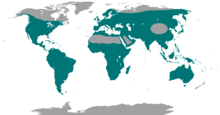Apodiformes
Traditionally, the bird order Apodiformes contained three living families: the swifts (Apodidae), the treeswifts (Hemiprocnidae), and the hummingbirds (Trochilidae). In the Sibley-Ahlquist taxonomy, this order is raised to a superorder Apodimorphae in which hummingbirds are separated as a new order, Trochiliformes. With nearly 450 species identified to date, they are the most diverse order of birds after the passerines.
| Apodiformes Temporal range: Late Paleocene to present | |
|---|---|
_immature_male.jpg) | |
| Bee hummingbird (Mellisuga helenae), the smallest birds in the World | |
| Scientific classification | |
| Kingdom: | Animalia |
| Phylum: | Chordata |
| Class: | Aves |
| Clade: | Strisores |
| Order: | Apodiformes Peters, 1940 |
| Families | |
| |
 | |
| Range of the swifts and hummingbirds. | |
| Synonyms | |
| |
Description
As their name ("footless" in Greek) suggests, their legs are small and have limited function aside from perching. The feet are covered with bare skin rather than the scales (scutes) that other birds have. Another shared characteristic is long wings with short, stout humerus bones.[1] The evolution of these wing characteristics has provided the hummingbird with ideal wings for hovering.[2]
The hummingbirds, swifts, and crested swifts share other anatomical similarities with one another, as well as similarities (notably as to the skull) with their probable closest living relatives, the owlet-nightjars.[3][4] The owlet-nightjars are apparently convergent with the closely related Caprimulgiformes, which form a clade Cypselomorphae with the Apodiformes.[2]
Evolution
The Apodiformes evolved in the Northern Hemisphere. Eocypselus, a primitive genus known from the Late Paleocene or Early Eocene of north-central Europe, is somewhat difficult to assign; it is considered a primitive hemiprocnid.[5] This would suggest that the major apodiform lineages diverged shortly after the Cretaceous–Paleogene boundary. However, the perching adaptation of the foot of Eocypselus on which this theory rests may just as well be a symplesiomorphy. Most researchers believe that presently this genus cannot be unequivocally assigned to either the Apodiformes or the Caprimulgiformes. The Early Eocene Primapus, found in England, is similar to both a primitive swift and the aegialornithids, which are in some aspects intermediate between swifts and owlet-nightjars. Fossil evidence demonstrates the existence of swifts during that period in Europe. At that time, most of Europe had a humid, subtropical climate, possibly comparable to modern-day southern China. For a map of Early–Middle Eocene Earth, see the Paleomap project;[6] here note that both the Caucasus mountains and the Alps did not exist yet and aegialornithids were possibly present in North America.[7] By the late Eocene (around 35 MYA), primitive hummingbirds started to diverge from the related jungornithids; the Middle Eocene Parargornis (Messel, Germany) and the Late Eocene Argornis, found in today's southernmost Russia, belong to this lineage. Cypselavus (Late Eocene – Early Oligocene of Quercy, France) was either a primitive hemiprocnid or an aegialornithid.
The placement of the Aegialornithidae is not quite clear. Various analyses place them sufficiently close to the Apodiformes to be included here, or into the unique owlet-nightjar lineage in the Cypselomorphae.
Taxonomy
ORDER APODIFORMES[8]
- Family †Aegialornithidae Lydekker 1891 [Primapinae Harrison 1984c]
- Genus †Primapus Harrison & Walker 1975
- Genus †Aegialornis Lydekker 1891
- Suborder Apodi
- Genus †Procypseloides Harrison 1984c
- Genus †Laputavis Dyke 2001b
- Genus †Scaniacypselus Harrison 1984
- Family †Eocypselidae Harrison 1984
- Genus †Eocypselus Harrison 1984Parargornis messelensis fossil
- Genus †Eocypselus Harrison 1984
- Family Hemiprocnidae Oberholser 1906 (treeswifts)
- Family Apodidae Olphe-Galliard 1887 (swifts)
- Suborder Trochili
- Genus †Palescyvus Karchu 1988
- Family †Cypselavidae Mourer-Chauviré 2006
- Genus †Argornis Karchu 1999
- Genus †Cypselavus Gaillard 1908
- Genus †Parargornis Mayr 2003
- Family †Jungornithidae Karchu 1988
- Genus †Jungornis Karchu 1988
- Family Trochilidae Vigors 1825 (hummingbirds)
See also
References
- Hyman, Libbie Henrietta (1992). Hyman's Comparative Vertebrate Anatomy. Chicago: University of Chicago Press, page 39. ISBN 0-226-87013-8
- Mayr, Gerald (2003): Phylogeny of early tertiary swifts and hummingbirds (Aves: Apodiformes). Auk 120(1): 145–151. doi:10.1642/0004-8038(2003)120[0145:POETSA]2.0.CO;2 PDF fulltext
- mayr
- Mayr, Gerald (2002): Osteological evidence for paraphyly of the avian order Caprimulgiformes (nightjars and allies). Journal für Ornithologie 143: 82–97. PDF fulltext
- Dyke, Gareth J.; Waterhouse, David M. & Kristoffersen, Anette M. (October 2004). "Three new fossil landbirds from the early Paleogene of Denmark" (PDF). Bulletin of the Geological Society of Denmark. 51 (1): 77–85.
- Christopher R. Scotese. "During the Early Cenozoic India began to Collide with Asia". Paleomap project. Retrieved 20 September 2010.
- Somewhat doubtful, as this is difficult to reconcile with the other aegialornithid fossils and Primapus.
- Haaramo, Mikko. "Apodiformes – housemartins, hummingbirds, and relatives". Mikko's Phylogeny Archive. Retrieved 30 December 2017.